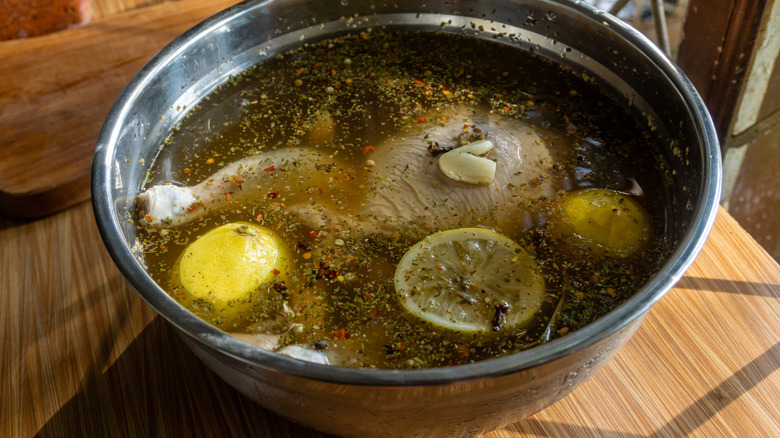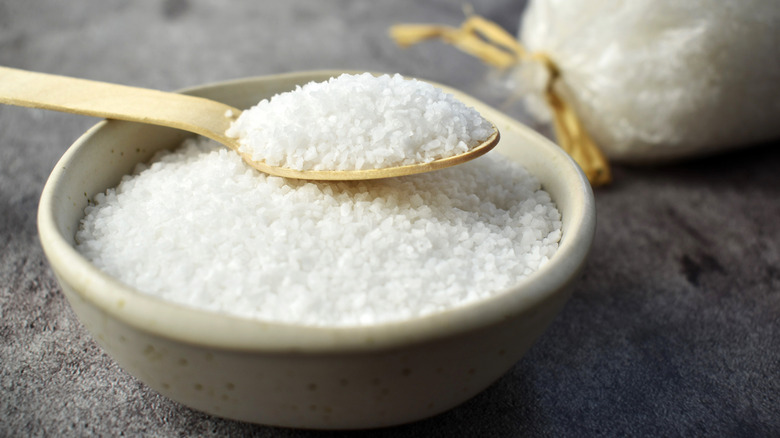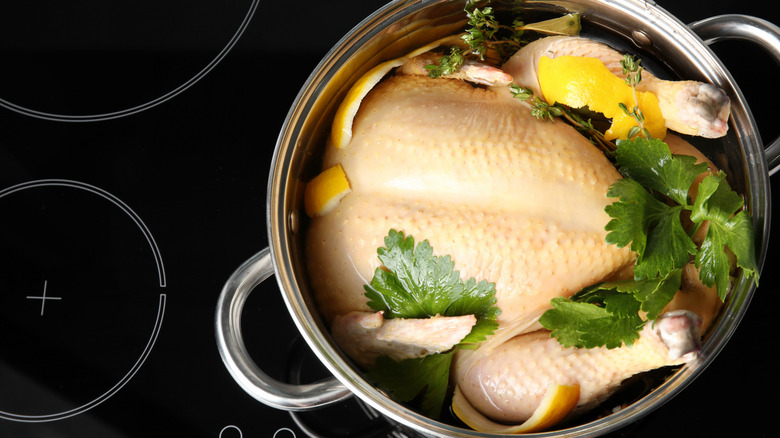Break Out The Brine, Even If You're Short On Time
For those with only a passing familiarity with the practice, brining probably conjures Thanksgiving-related visions of whole turkeys sitting in vats of liquid and orange peels for hours on end. And even if the submersion does produce a deliciously moist bird, who has the time to invest in that turkey texture? Well, actually, you do — because the technique of brining has a far wider application than holiday birds alone, and most meats don't need to be left soaking overnight. Nearly any protein can benefit from a brine, and many types of meat and seafood need to sit for as little as 30 minutes to feel its tenderizing effects.
First things first: Brine is the key to moist meat. It's a salt and water solution that penetrates the meat and denatures proteins and muscle fibers. The salt solution works its way through the meat, which is less salty than the brine, in order to equalize the salt concentration on both sides of the membrane — a chemical process known as osmosis. When muscle fibers and proteins are broken down and dissolved by the mixture, the texture of the meat changes, becoming more tender, losing some of its toughness, and allowing more moisture to be introduced. For the denaturing, dissolving, and osmosis process to complete, a whole turkey may need about 12 hours to sit, but for smaller cuts of lean meat, even a brief brining time of 30 minutes helps avoid the dreaded dry texture.
Nail the time and salt ratios for a quick brine
Most of the time, you can operate under the assumption that meat requires about an hour of brine time per pound, but that length won't always be necessary to achieve the flavor and texture you're looking for. Brining boneless chicken or boneless pork chops will only require about 30 minutes, while seafood like shrimp, fish fillets, or scallops will take between 15 and 30 minutes. Even bone-in chicken and pork chops, whole fish, and pork tenderloin will be ready in about an hour. If you get a little distracted by the rest of the recipe while the protein brines, you'll be just fine — but don't let these kinds of meats sit in brine for hours, as they will become over-salted and may even turn mushy as the salt goes too far with its protein dissolution.
Speaking of salt: A typical brine uses anywhere from 5% to 10% salt relative to the volume of water, and a higher concentration means a shorter brining time. Dinner portions of your protein will probably require about four cups of water to be fully covered — mixing that with about ¼ cup of salt creates a good (and easy-to-remember) brine concentration.
Speed up your brine with a boost of flavor
Although the most basic brine consists of just salt and water, there's nothing stopping you from branching out with spices, sugars, and fruit tossed into the mix. The solution infuses its flavor, so additional ingredients mean the protein will emerge with a delicious taste as well as an improved texture. Plus, some flavorful ingredients can even speed up that (already quick) brining process.
Salt is still required to ensure the correct chemical reaction, but you can replace some or all of the water in a brine. Sweet tea is a secret ingredient for fried chicken brine, and you can even soak your turkey in buttermilk for ultra-tender results. If you choose an acidic liquid for your base, like orange juice (great for ribs) or vinegar, the meat will tenderize more quickly, and the brine time will need to be shortened.
A similar denaturing process occurs when meat is exposed to acid as when it's exposed to a salt solution. The hydrogen bonds that give proteins their shape are broken and unravel when acid is introduced. However, if this process goes on too long, the meat becomes tough as different kinds of bonds form with other molecules. So your quick brine should be even quicker if you want to avoid giving the meat the wrong texture.



